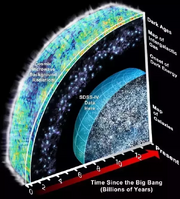
The cosmic microwave background (CMB) is electromagnetic radiation left over from an early stage of the universe. The farthest we can now observe with electromagnetic sensors is back to a time when the universe was about 300,000 years old, when matter and radiation finally “decoupled”.
The accidental discovery of the CMB in 1965 by American radio astronomers Arno Penzias and Robert Wilson earned them the 1978 Nobel Prize in Physics, because it is evidence of the Big Bang origin of the universe.
More precise measurements were made by the COBE (Cosmic Background Explorer) satellite, launched in 1989, which determined a temperature of 2.735 K. COBE also allowed researchers to measure small fluctuations in the intensity of the background radiation, which corresponded to the beginning of structures, such as galaxies, in the universe.
The Wilkinson Microwave Anisotropy Probe (WMAP) was a NASA spacecraft operating from 2001 to 2010 which measured temperature differences across the sky in CMB. WMAP's measurements played a key role in establishing the current Standard Model of Cosmology, that the universe is dominated by dark energy, and the age of the universe at 13.772 billion years. According to Science magazine, the WMAP was the Breakthrough of the Year for 2003.
We find that there is roughly one proton in the universe today for every 10 billion photons in the CMB. This means that the original excess of protons over antiprotons was only about 1 part in 10 billion! This would have been sufficient to have produced all the observed matter in the universe and how it got to be made of matter and not antimatter.
